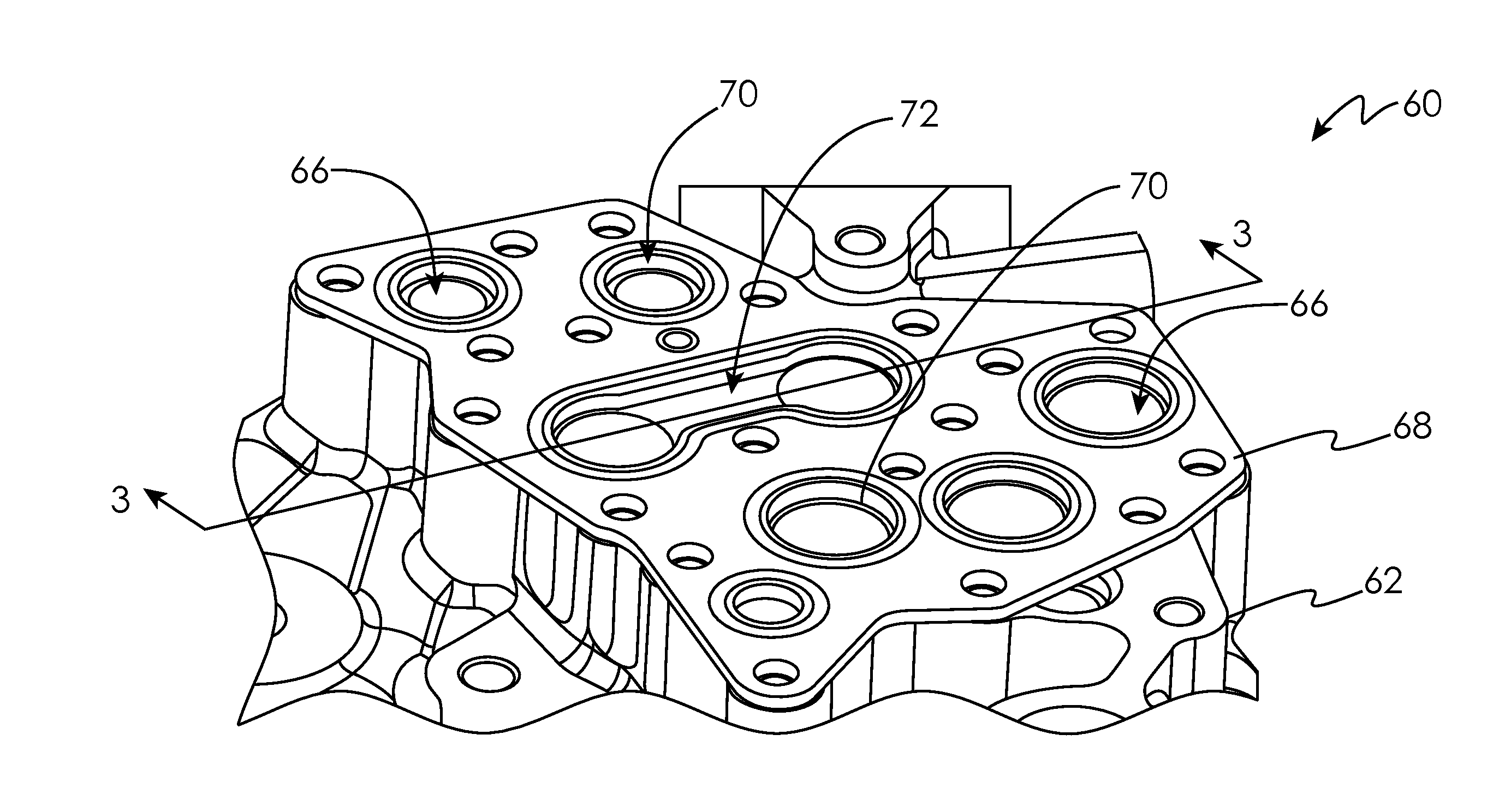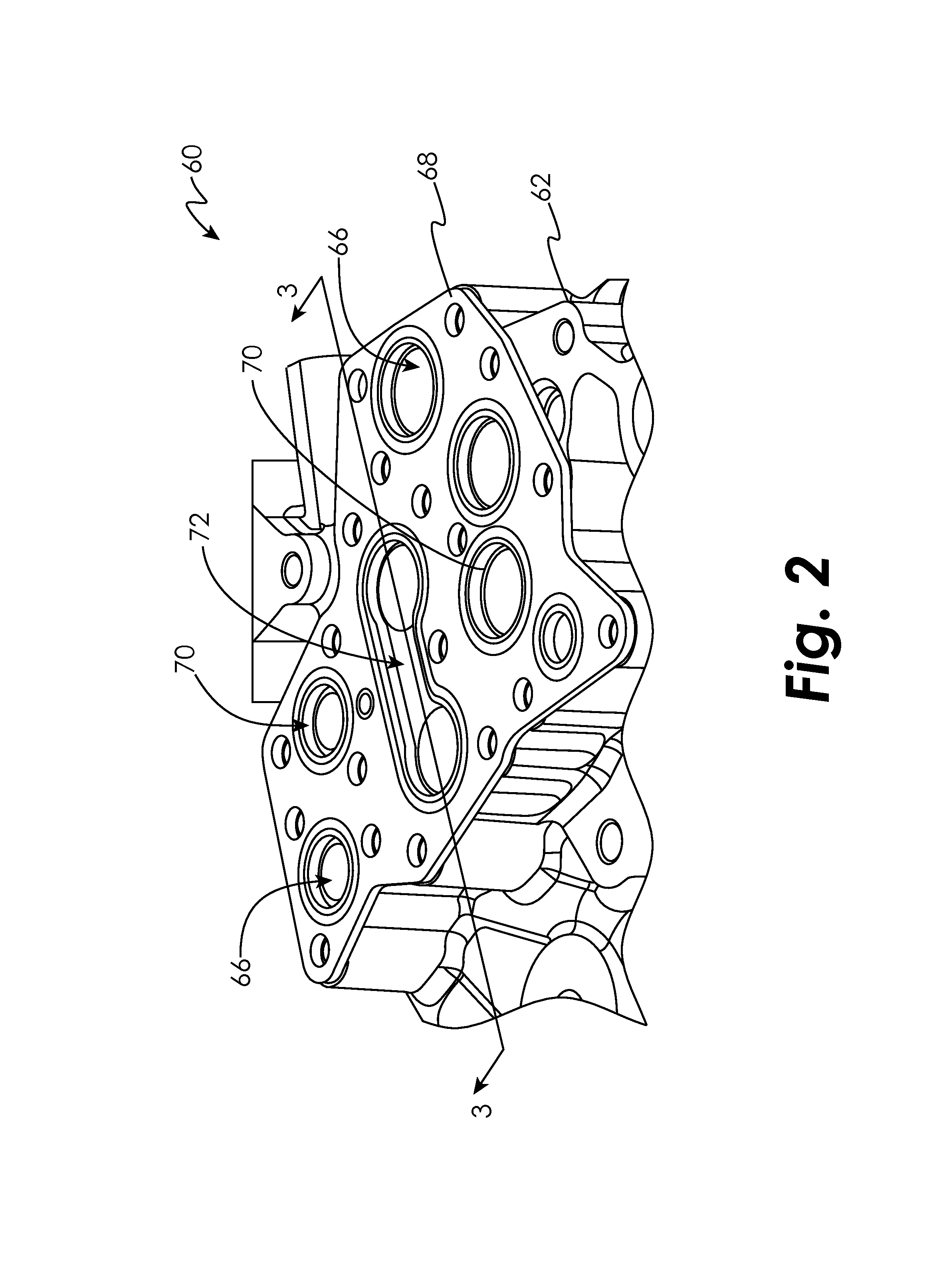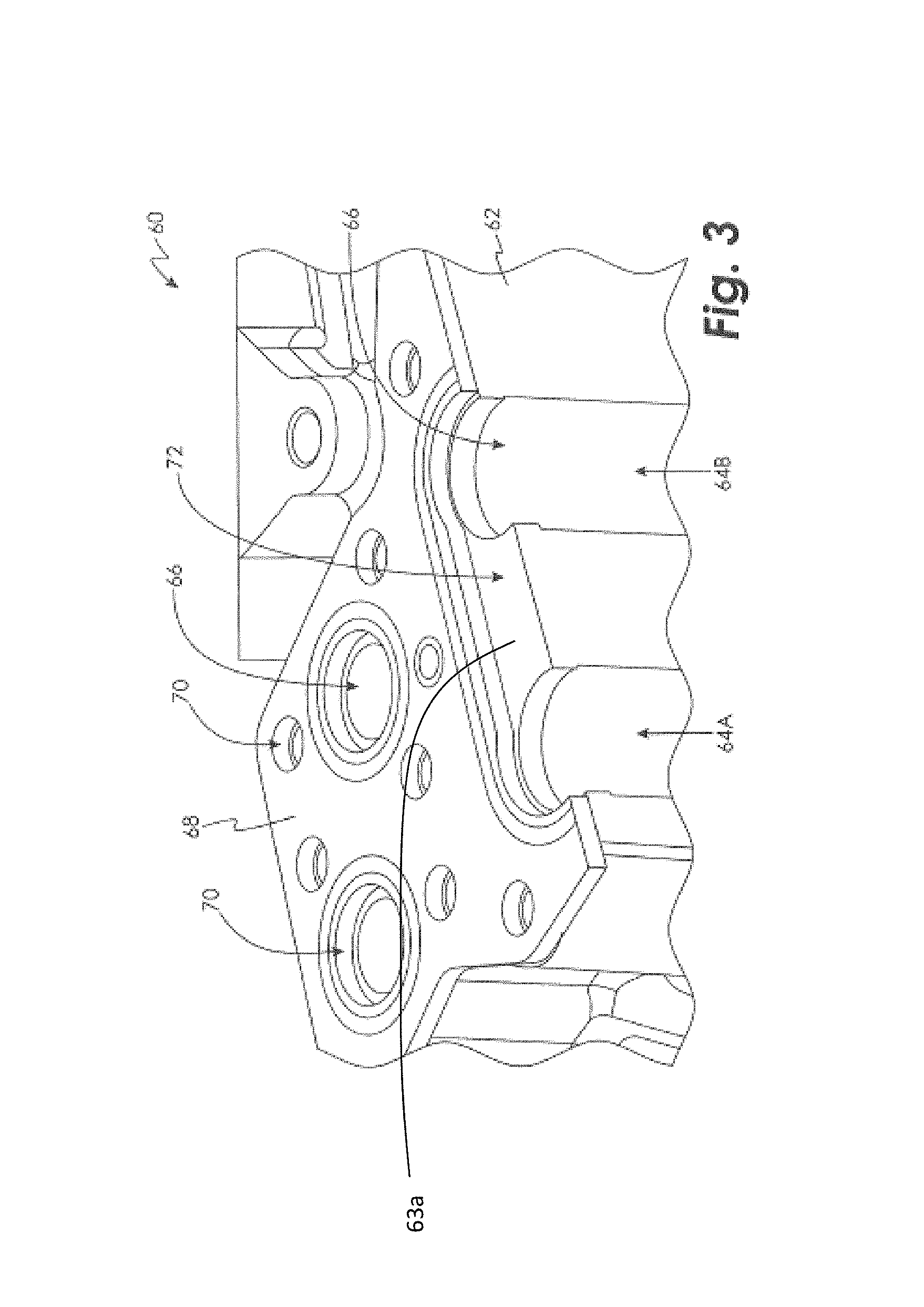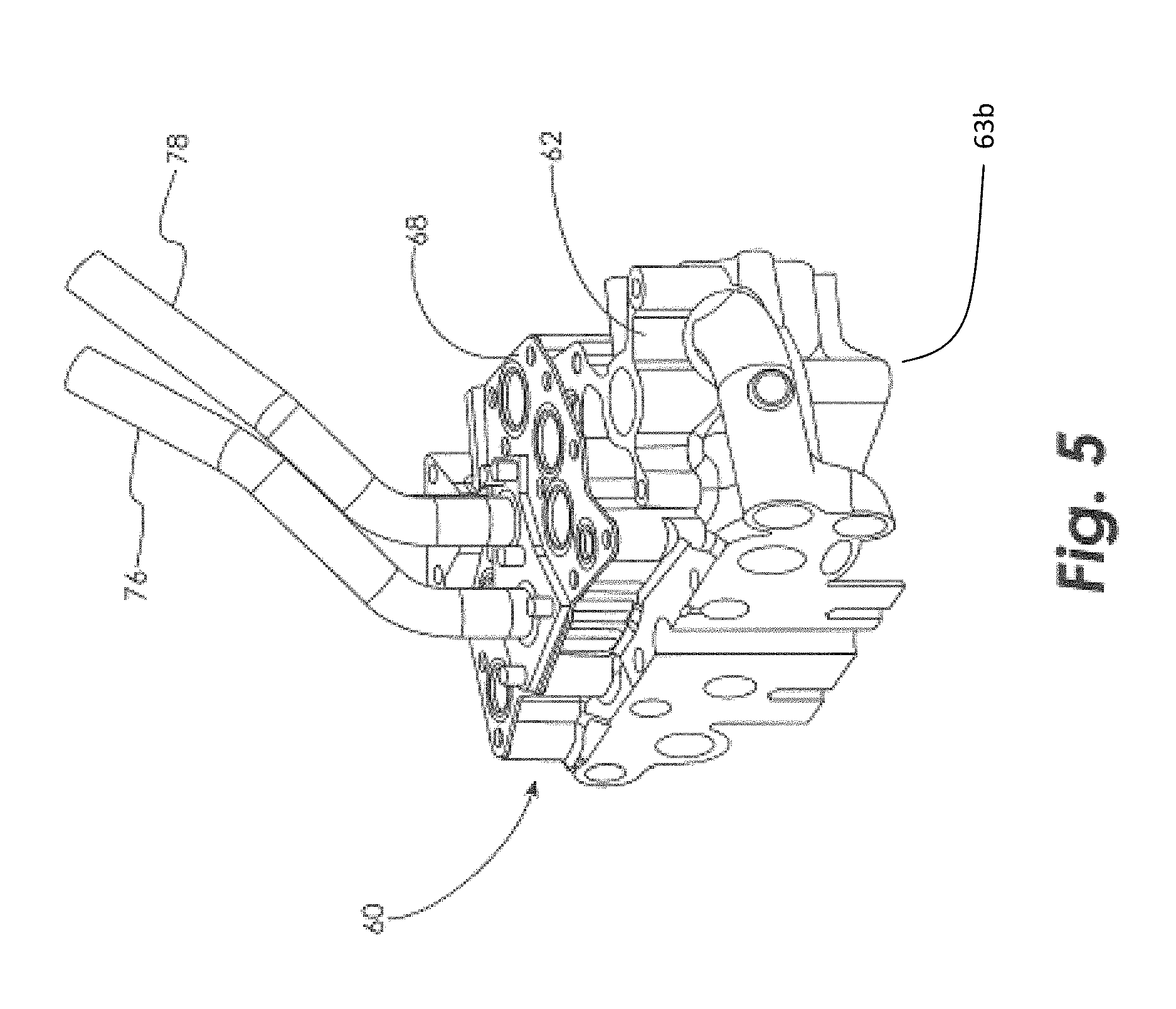Seal plate with fluid bypass control
Meyst , et al.
U.S. patent number 10,280,840 [Application Number 14/623,309] was granted by the patent office on 2019-05-07 for seal plate with fluid bypass control. This patent grant is currently assigned to UNITED TECHNOLOGIES CORPORATION. The grantee listed for this patent is UNITED TECHNOLOGIES CORPORATION. Invention is credited to Jonas S. Banhos, William Meyst, Andre Herman Troughton.






| United States Patent | 10,280,840 |
| Meyst , et al. | May 7, 2019 |
Seal plate with fluid bypass control
Abstract
The present disclosure relates generally to a manifold including a plurality of manifold channels disposed therethrough, each manifold channel including a manifold channel opening, and a seal plate, including a plurality of seal plate apertures disposed thereon, operably coupled to the manifold, wherein the seal plate includes at least one seal plate channel extending between at least two of the plurality of seal plate apertures.
| Inventors: | Meyst; William (Middletown, CT), Banhos; Jonas S. (New Haven, CT), Troughton; Andre Herman (Windsor Locks, CT) | ||||||||||
|---|---|---|---|---|---|---|---|---|---|---|---|
| Applicant: |
|
||||||||||
| Assignee: | UNITED TECHNOLOGIES CORPORATION
(Farmington, CT) |
||||||||||
| Family ID: | 53365709 | ||||||||||
| Appl. No.: | 14/623,309 | ||||||||||
| Filed: | February 16, 2015 |
Prior Publication Data
| Document Identifier | Publication Date | |
|---|---|---|
| US 20160356220 A1 | Dec 8, 2016 | |
Related U.S. Patent Documents
| Application Number | Filing Date | Patent Number | Issue Date | ||
|---|---|---|---|---|---|
| 61980090 | Apr 16, 2014 | ||||
| Current U.S. Class: | 1/1 |
| Current CPC Class: | F01D 25/183 (20130101); F01D 25/18 (20130101); F02C 7/06 (20130101); F02C 7/28 (20130101); F05D 2220/32 (20130101); F05D 2260/98 (20130101); F05D 2240/55 (20130101) |
| Current International Class: | F02C 7/06 (20060101); F02C 7/28 (20060101); F01D 25/18 (20060101) |
| Field of Search: | ;137/884 |
References Cited [Referenced By]
U.S. Patent Documents
| 4951709 | August 1990 | Kirkham |
| 5610341 | March 1997 | Tortora |
| 5803124 | September 1998 | Newton |
| 8371254 | February 2013 | Beyer |
| 8616003 | December 2013 | Hollon |
| 2012/0031354 | February 2012 | Beyer et al. |
| 0540192 | May 1993 | EP | |||
Other References
|
European Communication and Search Report; Application No. 15163830.1-1607; dated Sep. 9, 2015; 6 pages. cited by applicant. |
Primary Examiner: Fristoe, Jr.; John K
Assistant Examiner: Barry; Daphne M
Attorney, Agent or Firm: Cantor Colburn LLP
Parent Case Text
CROSS REFERENCE TO RELATED APPLICATIONS
The present application is related to, and claims the priority benefit of, U.S. Provisional Patent Application Ser. No. 61/980,090 filed Apr. 16, 2014, the contents of which are hereby incorporated in their entirety into the present disclosure.
Claims
What is claimed is:
1. A method of regulating pressure between fluidly coupled manifold assemblies in a gas turbine engine, the gas turbine engine comprising: a manifold assembly, wherein the manifold assembly comprises: a manifold having a first surface and a second surface, the first surface being a top surface of the manifold and the second surface being a bottom surface of the manifold, the manifold including a plurality of adjacently disposed manifold channels extending through the manifold, the plurality of manifold channels including a first manifold channel and a second manifold channel; a plurality of manifold channel openings respectively disposed at the first surface of the manifold, above the plurality of manifold channels, the plurality of manifold channel openings including a first manifold channel opening disposed above the first manifold channel and a second manifold channel opening disposed above the second manifold channel; and a seal plate disposed above the first surface of the manifold and including a plurality of seal plate apertures, operably coupled to the manifold, the plurality of seal plate apertures including a first seal plate aperture disposed above the first manifold channel opening and a second seal plate aperture disposed above the second manifold channel opening; and the seal plate including at least a first seal plate channel longitudinally extending between and connecting the first seal plate aperture and the second seal plate aperture, wherein the first seal plate channel is longitudinally symmetrical and has a first end and a longitudinally opposing second end, and the seal plate channel includes a middle portion disposed longitudinally between the first end and the second end, and the middle portion has a constricted transverse span to define a constricted flow area, wherein each of the plurality of seal plate apertures is aligned with a respective one of the plurality of first manifold channel openings, and the first seal plate aperture and the second seal plate aperture connected by and adjacent to the first seal plate channel, a stepwise transition to the constricted flow area of the middle portion of the first seal plate channel from a longitudinally adjacent portion of the first seal plate channel, wherein the first seal plate channel is transversely symmetrical, and the manifold assembly is a first manifold assembly and the gas turbine engine further comprises a second manifold assembly operably coupled to the seal plate to create a fluid circuit between the first manifold assembly and the second manifold assembly, and the method comprising: circulating fluid through the fluid circuit in the gas turbine engine, wherein fluid is supplied to the second manifold assembly from the first manifold assembly via fluid flowing consecutively through the first manifold channel, the first manifold opening, and the first seal plate aperture, and wherein the circulating fluid is returned to the first manifold assembly from the second manifold assembly via fluid flowing consecutively through the second seal plate aperture, the second manifold opening, and the second manifold channel; and regulating fluid pressure within the fluid circuit via a fluid bypass defined by the first seal plate channel connecting the first seal plate aperture and the second seal plate aperture.
Description
TECHNICAL FIELD OF THE DISCLOSED EMBODIMENTS
The present disclosure is generally related to gas turbine engines and, more specifically, to a seal plate with fluid bypass control.
BACKGROUND OF THE DISCLOSED EMBODIMENTS
Traditionally, manifolds for use with gas turbine engines are comprised of a single-piece part that comprises a cast component with cored flow passages. As fluids are pumped through the manifold, pressure builds therein which requires a bypass to relieve the pressure. Such bypasses may be integral to the manifold or external; thus, resulting in increased costs for the manifold assembly.
Improvements in manifold assemblies are therefore needed in the art.
SUMMARY OF THE DISCLOSED EMBODIMENTS
In one aspect, a manifold assembly is provided. The manifold assembly includes a manifold including a plurality of manifold channels disposed therethrough, each of the plurality of manifold channels including a manifold channel opening. The manifold assembly further includes a seal plate operably coupled to the manifold. The seal plate includes a plurality of seal plate apertures disposed thereon. Each of the manifold channel openings are aligned with a respective one of the seal plate apertures.
The seal plate further includes at least one seal plate channel connecting at least two of the plurality of seal plate apertures to allow a fluid to pass therethrough. In at least one embodiment, the at least two seal plate apertures connected by the at least one seal plate channel are adjacent to one another.
In at least one embodiment, the at least one seal plate channel includes a bypass type channel. In at least one embodiment, the at least one seal plate channel includes a venturi type channel. In at least one embodiment, the at least one seal plate channel includes an orifice type channel. In at least one embodiment, a first one of the at least one seal plate channels extends between a first one of the plurality of seal plate apertures and a second one of the at least one seal plate channels.
Other embodiments are also disclosed.
BRIEF DESCRIPTION OF THE DRAWINGS
The embodiments and other features, advantages and disclosures contained herein, and the manner of attaining them, will become apparent and the present disclosure will be better understood by reference to the following description of various exemplary embodiments of the present disclosure taken in conjunction with the accompanying drawings, wherein:
FIG. 1 is a schematic cross-sectional view of a gas turbine engine;
FIG. 2 is a perspective view of a manifold assembly in an embodiment;
FIG. 3 is a cross-sectional view of a manifold assembly in an embodiment;
FIGS. 4A-D are front views of embodiments of seal plate channels; and
FIG. 5 is a perspective view of a pair of manifold assemblies operably coupled to one another to create a fluid circuit in an embodiment.
DETAILED DESCRIPTION OF THE DISCLOSED EMBODIMENTS
For the purposes of promoting an understanding of the principles of the present disclosure, reference will now be made to the embodiments illustrated in the drawings, and specific language will be used to describe the same. It will nevertheless be understood that no limitation of the scope of this disclosure is thereby intended.
FIG. 1 schematically illustrates a gas turbine engine 20. The gas turbine engine 20 is disclosed herein as a two-spool turbofan that generally incorporates a fan section 22, a compressor section 24, a combustor section 26 and a turbine section 28. Alternative engines might include an augmentor section (not shown) among other systems or features. The fan section 22 drives air along a bypass flow path B in a bypass duct, while the compressor section 24 drives air along a core flow path C for compression and communication into the combustor section 26 then expansion through the turbine section 28. Although depicted as a two-spool turbofan gas turbine engine in the disclosed non-limiting embodiment, it should be understood that the concepts described herein are not limited to use with two-spool turbofans as the teachings may be applied to other types of turbine engines including three-spool architectures.
The exemplary engine 20 generally includes a low speed spool 30 and a high speed spool 32 mounted for rotation about an engine central longitudinal axis A relative to an engine static structure 36 via several bearing systems 38. It should be understood that various bearing systems 38 at various locations may alternatively or additionally be provided, and the location of bearing systems 38 may be varied as appropriate to the application.
The low speed spool 30 generally includes an inner shaft 40 that interconnects a fan 42, a low pressure compressor 44 and a low pressure turbine 46. The inner shaft 40 is connected to the fan 42 through a speed change mechanism, which in exemplary gas turbine engine 20 is illustrated as a geared architecture 48 to drive the fan 42 at a lower speed than the low speed spool 30. The high speed spool 32 includes an outer shaft 50 that interconnects a high pressure compressor 52 and high pressure turbine 54. A combustor 56 is arranged in exemplary gas turbine 20 between the high pressure compressor 52 and the high pressure turbine 54. An engine static structure 36 is arranged generally between the high pressure turbine 54 and the low pressure turbine 46. The engine static structure 36 further supports bearing systems 38 in the turbine section 28. The inner shaft 40 and the outer shaft 50 are concentric and rotate via bearing systems 38 about the engine central longitudinal axis A which is collinear with their longitudinal axes.
The core airflow is compressed by the low pressure compressor 44 then the high pressure compressor 52, mixed and burned with fuel in the combustor 56, then expanded over the high pressure turbine 54 and low pressure turbine 46. The turbines 46, 54 rotationally drive the respective low speed spool 30 and high speed spool 32 in response to the expansion. It will be appreciated that each of the positions of the fan section 22, compressor section 24, combustor section 26, turbine section 28, and fan drive gear system 48 may be varied. For example, gear system 48 may be located aft of combustor section 26 or even aft of turbine section 28, and fan section 22 may be positioned forward or aft of the location of gear system 48.
The engine 20 in one example is a high-bypass geared aircraft engine. In a further example, the engine 20 bypass ratio is greater than about six (6), with an example embodiment being greater than about ten (10), the geared architecture 48 is an epicyclic gear train, such as a planetary gear system or other gear system, with a gear reduction ratio of greater than about 2.3 and the low pressure turbine 46 has a pressure ratio that is greater than about five. In one disclosed embodiment, the engine 20 bypass ratio is greater than about ten (10:1), the fan diameter is significantly larger than that of the low pressure compressor 44, and the low pressure turbine 46 has a pressure ratio that is greater than about five 5:1. Low pressure turbine 46 pressure ratio is pressure measured prior to inlet of low pressure turbine 46 as related to the pressure at the outlet of the low pressure turbine 46 prior to an exhaust nozzle. The geared architecture 48 may be an epicycle gear train, such as a planetary gear system or other gear system, with a gear reduction ratio of greater than about 2.3:1. It should be understood, however, that the above parameters are only exemplary of one embodiment of a geared architecture engine and that the present invention is applicable to other gas turbine engines including direct drive turbofans.
A significant amount of thrust is provided by the bypass flow B due to the high bypass ratio. The fan section 22 of the engine 20 is designed for a particular flight condition--typically cruise at about 0.8 Mach and about 35,000 feet (10,688 meters). The flight condition of 0.8 Mach and 35,000 ft., with the engine at its best fuel consumption--also known as "bucket cruise Thrust Specific Fuel Consumption (`TSFC`)"--is the industry standard parameter of lbm of fuel being burned divided by lbf of thrust the engine produces at that minimum point. "Low fan pressure ratio" is the pressure ratio across the fan blade alone, without a Fan Exit Guide Vane ("FEGV") system. The low fan pressure ratio as disclosed herein according to one non-limiting embodiment is less than about 1.45. "Low corrected fan tip speed" is the actual fan tip speed in ft/sec divided by an industry standard temperature correction of [(Tram .degree. R)/(518.7.degree. R)].sup.0.5. The "Low corrected fan tip speed" as disclosed herein according to one non-limiting embodiment is less than about 1150 ft/second (350.5 m/sec).
FIGS. 2 and 3 schematically illustrate a manifold assembly 60. The manifold assembly 60 includes a manifold 62 having a manifold first surface 63a (FIG. 3) which is a top surface of the manifold and a manifold second surface 63b (FIG. 5) which is a bottom surface of the manifold, and including a plurality of manifold channels 64 (channels 64A and 64B shown) disposed therethrough, each of the plurality of manifold channels 64 including a manifold channel opening 66. The manifold assembly 60 further includes a seal plate 68 operably coupled to the manifold 62. It will be appreciated that the seal plate may be composed of any suitable material such as aluminum, steel, and titanium to name a few non-limiting examples. The seal plate 68 includes a plurality of seal plate apertures 70 disposed thereon. Each of the manifold channel openings 66 are aligned with a respective one of the seal plate apertures 70.
The seal plate 68 further includes at least one seal plate channel 72 connecting at least two of the plurality of seal plate apertures 70 to allow a fluid to pass therethrough. In at least one embodiment, the at least two seal plate apertures 70 connected by the at least one seal plate channel 72 are adjacent to one another. The at least one seal plate channel 72 is configured to regulate a fluid pressure of a fluid circuit later described herein.
In at least one embodiment, as shown in FIG. 4A, the at least one seal plate channel 72 includes a bypass type channel. In at least one embodiment, as shown in FIG. 4B, the at least one seal plate channel 72 includes a venturi type channel. As defined herein, a venturi type channel is an opening which employs a temporary restriction or narrowing along at least a portion of its length. In at least one embodiment, as shown in FIG. 4C, the at least one seal plate channel 72 includes an orifice type channel. As defined herein, an orifice type channel is an opening which employs a temporary restriction in the middle and widens towards the ends. FIG. 4D shows an embodiment where a first seal plate channel 72A extends between seal plate apertures 70A and 70B, positioned adjacent to one another, and a second seal plate channel 72B extending between seal plate aperture 70C and the first seal plate channel 72A. This arrangement may be used to reduce fluid pressure within a fluid circuit connected to seal plate apertures 70A and 70B, as well as expel fluid from the manifold 62 through seal plate aperture 70C.
FIG. 5 schematically illustrates a seal plate 68 operably coupled to a first manifold assembly 60, and a second manifold assembly (not shown) operably coupled to the seal plate 68 via a pair of conduits 76 and 78. The conduits 76 and 78 create a fluid circuit to circulate a fluid between the first manifold assembly 60 and the second manifold assembly at a circuit flow rate. For example, oil to name one non-limiting example, is circulated between the manifold channel 64A (as shown in FIG. 3) of the first manifold assembly 60 through conduit 76 to a manifold channel (not shown) of the second manifold assembly. The fluid returns to the manifold channel 64B of first manifold assembly 60 via the conduit 78. Fluid is circulated in the aforementioned fluid circuit to aid in the lubrication of parts within the gas turbine engine 20. As the fluid circulates between the first manifold assembly 60 and the second manifold assembly, pressure builds within the fluid circuit. To relieve and/or regulate the fluid pressure within the fluid circuit, the at least one seal plate channel 72 creates a bypass between manifold channels 64A and 64B. It will be appreciated that the geometry of the at least one seal plate channel 72 and the cross-sectional area of the at least one seal plate channel 72 is selected based on a mass flow rate and a downstream pressure drop of the fluid circuit.
It will be appreciated that the seal plate 68 includes at least one seal plate channel 72 connecting at least two of the plurality of seal plate apertures 70 disposed thereon to create a bypass that regulates the pressure in a fluid circuit. It will also be appreciated that the at least one seal plate channel 72 reduces costs of the manifold assembly 60, and increases design flexibility of the manifold assembly 60 to meet flow requirements of the fluid circuit as additional parts or machine tooling would not be required to create a necessary bypass.
While the invention has been illustrated and described in detail in the drawings and foregoing description, the same is to be considered as illustrative and not restrictive in character, it being understood that only certain embodiments have been shown and described and that all changes and modifications that come within the spirit of the invention are desired to be protected.
* * * * *
D00000

D00001

D00002

D00003

D00004

D00005

XML
uspto.report is an independent third-party trademark research tool that is not affiliated, endorsed, or sponsored by the United States Patent and Trademark Office (USPTO) or any other governmental organization. The information provided by uspto.report is based on publicly available data at the time of writing and is intended for informational purposes only.
While we strive to provide accurate and up-to-date information, we do not guarantee the accuracy, completeness, reliability, or suitability of the information displayed on this site. The use of this site is at your own risk. Any reliance you place on such information is therefore strictly at your own risk.
All official trademark data, including owner information, should be verified by visiting the official USPTO website at www.uspto.gov. This site is not intended to replace professional legal advice and should not be used as a substitute for consulting with a legal professional who is knowledgeable about trademark law.